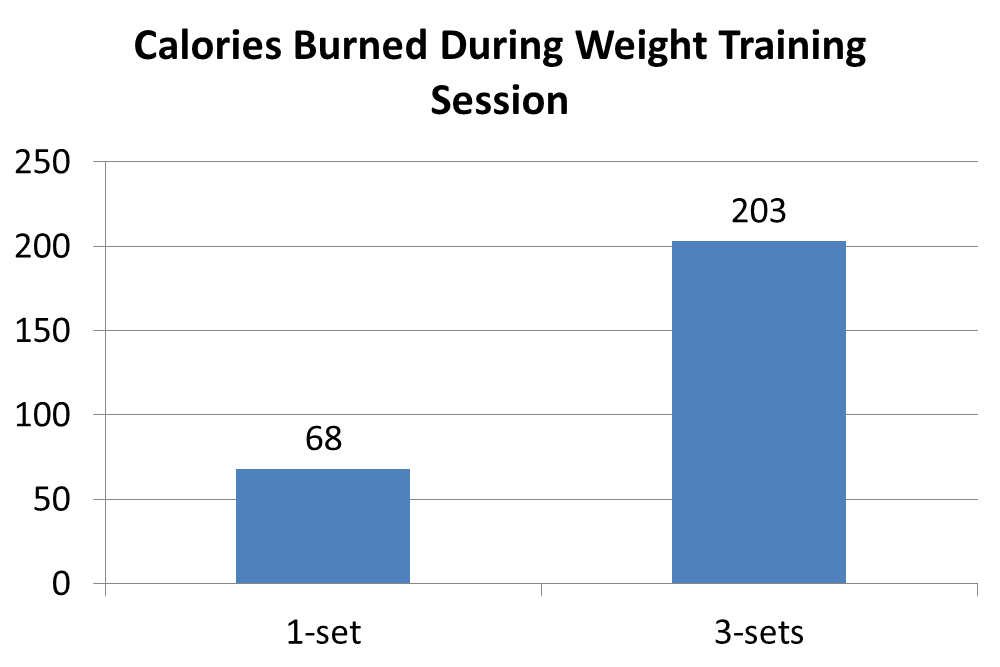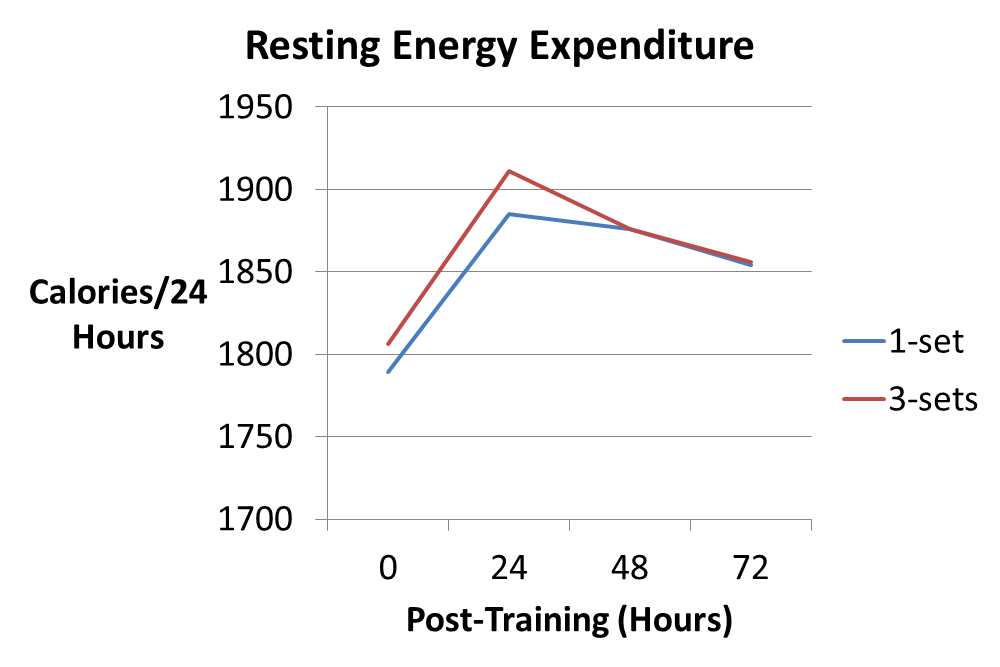When you exercise, you don't just burn calories during a session, but you also burn calories after your' finished. Some people call this a caloric "afterburn". Here at Weightology, you have learned that the "afterburn" caused by moderate exercise is quite small, amounting to only an extra 30 calories per day or so. The "afterburn" caused by intense interval training isn't much better, perhaps giving you about 30 more calories of energy expenditure during recovery compared to moderate exercise. The only type of exercise that does give you a sizable increase in energy expenditure during recovery is resistance training. In fact, a high volume resistance training session can increase your metabolism by up to 8-9% for 3 days after the session is complete. Of course, this is for a high volume session. There are many people, either because they may lack time or are proponents of High Intensity Training (HIT), who engage in low volume weight training, often only doing 1-3 sets per exercise. The question then becomes whether low volume resistance training can give you an "afterburn." Fortunately scientists were asking the same question, and published their results in the European Journal of Applied Physiology.
The Study
In this study, the researchers compared the effects of a 1-set weight training session to a 3-set weight training session on resting energy expenditure (REE) for 72 hours after the training session was complete. Ten college-aged men without any weight training experience were recruited for the study, while 8 completed it. The men were tested for their 10-rep max (RM) on ten different exercises (leg press, leg curl, calf raise, bench press, lat pull-down, shoulder press, biceps curl, triceps extension, abdominal crunch, and back extension). One week later, the men came into the lab after an overnight fast. Their REE was tested, and then they engaged in either the 1-set or 3-set weight training session. REE was again tested at 24, 48, and 72 hours after the weight training session. One week later, the subjects repeated the entire process, except they engaged in the opposite training session. The order that the subjects did the 1-set and 3-set training sessions was random and counterbalanced (meaning 4 subjects started with the 1-set protocol and 4 subjects started with the 3-set protocol). Energy expenditure was also measured during the weight training session using a portable gas analyzer. The subjects also wore accelerometers during the training session and for the 72 hours afterwards. Each training session consisted of the ten exercises mentioned earlier. The exercises were divided into three circuit rotations, each consisting of 3-4 different exercises. Rotation one consisted of the leg press, bench press, and leg curl. Rotation two consisted of the lat pull-down, calf raise, and shoulder press. Rotation three consisted of the biceps curl, triceps extension, abdominal crunch, and back extension. The subjects took 30 seconds of rest between each set, and 4 minutes rest between each rotation. All lifts were done using a 2-second concentric and 4-second eccentric tempo. All exercises were done using Paramount weight stack machines.
The Results
As you would expect, subjects burned significantly more calories during the 3-set protocol compared to the 1-set protocol:
REE was elevated for 72 hours in both groups by a similar amount:
The results were similar when corrected for lean body mass. The average percentage increase for REE over the 3 days was 5.2% for the 1-set condition and 4.6% for the 3-set condition. The overall average increase for both conditions was about 79 calories per day.
Similar Afterburn, But Don't Forget The Session Itself!
This study showed that a weight training session consisting of 1 set per exercise for 10 exercises caused a similar increase in post-exercise energy expenditure when compared to 3 sets per exercise. Thus, you are likely going to get around a 5% increase in your metabolism for 3 days when training with a volume of 1-3 sets per exercise. This is going to be around 80 calories per day in someone who weighs around 200 pounds. While this is not an enormous amount, it is still equivalent to a 15 minute brisk walk in a 200 pound person. It is likely going to take higher resistance training volumes, and/or an emphasis on the eccentric or negative portion of a lift, to get a larger increase.
While there is no difference in the "afterburn" of a 1-set session compared to a 3-set session, you can't forget about the calories burned during the training session. In this study, the 3-set protocol clearly wins out, resulting in 135 more calories burned. Thus, when you add the calories burned during the session to the calories burned after the session, the 3-set protocol is superior, despite the fact that post-exercise energy expenditure is similar to that of a 1-set protocol. Combine that with the fact that you will build more muscle with 3 sets compared to 1 set, and a 3-set protocol is the better way to go if you want to lose fat and increase muscle. Of course, if you are someone who is lacking in time, this study shows that you can still get nice benefits from a 1-set training session.
As with any study, there are limitations to consider. The sample size in this study was extremely small (only 8 subjects); it can be difficult to detect differences between groups with such a small sample. There could be differences between a 1-set and 3-set protocol that would become apparent with a larger sample size. The study was performed on young, college-aged men, which is a very specific population in terms of their characteristics. Results could be different for different age groups or for women. Finally, the men had no weight training experience; results could be different for people with weight training experience.
Overall, you're going to get a similar "afterburn" when doing 1 set per exercise compared to 3 sets per exercise. However, you're going to burn more calories overall with a 3-set session when you include the calories burned during the session. You're also going to build more muscle with a 3-set session. If time is not an issue, you should go with multiple sets per exercise to maximize both your fat loss and muscle gain. However, if you have a busy lifestyle and are limited on time, you can still get significant benefits with one set per exercise.
PRIMARY REFERENCE


